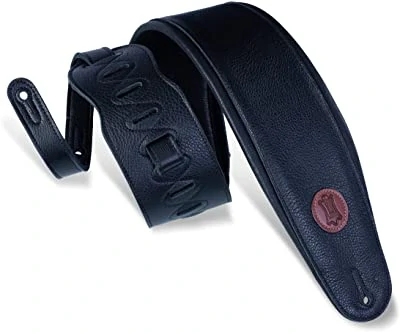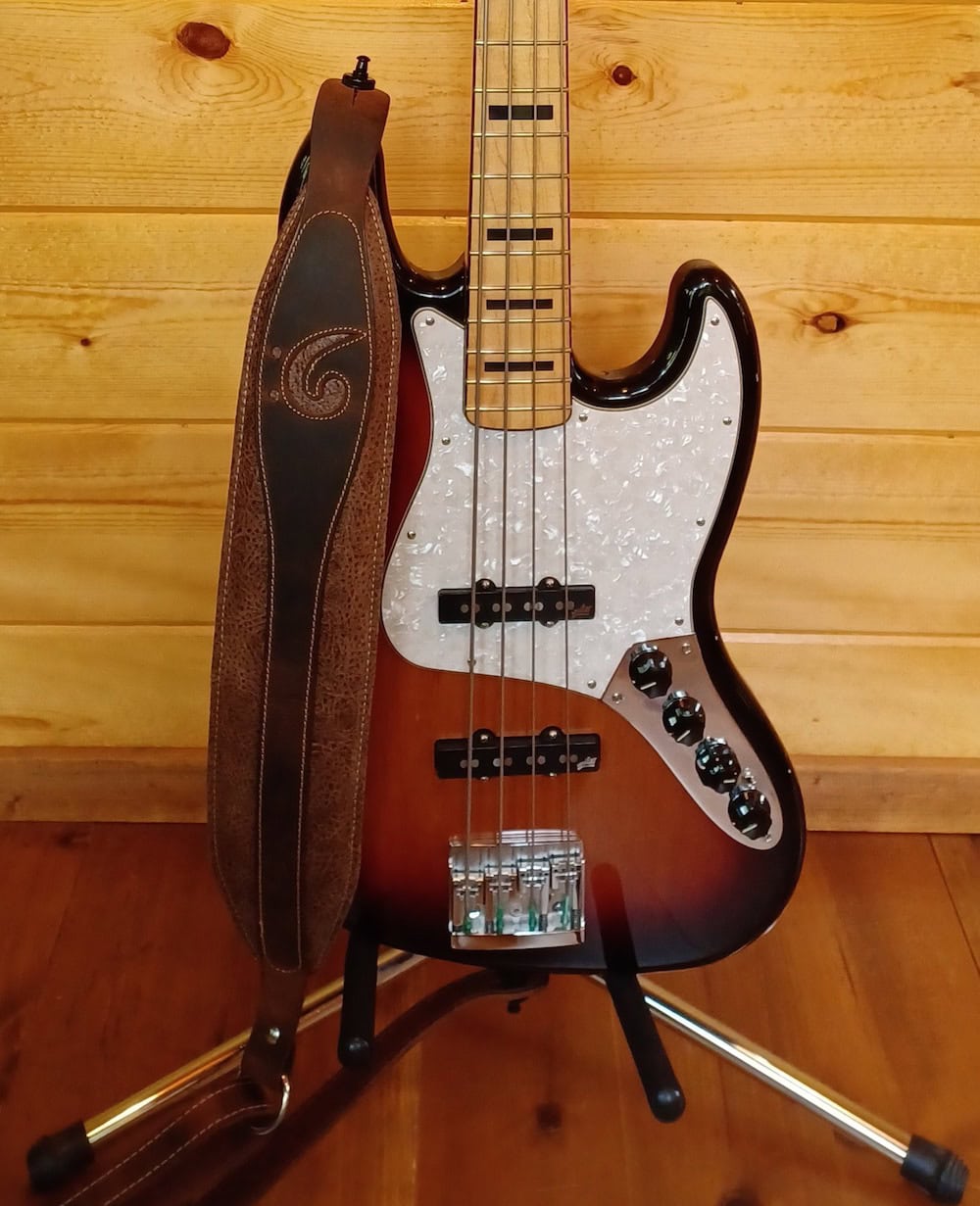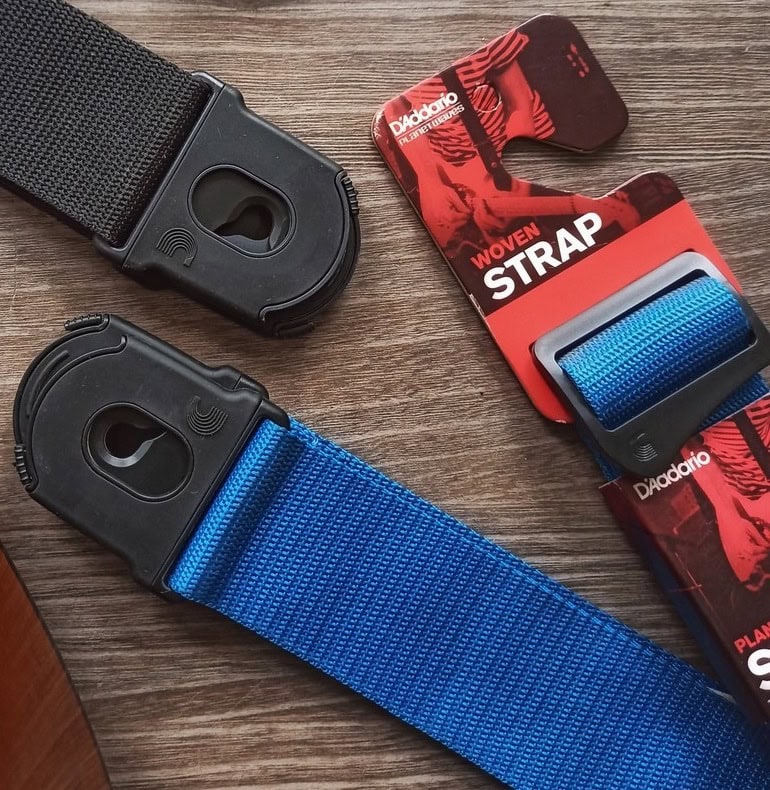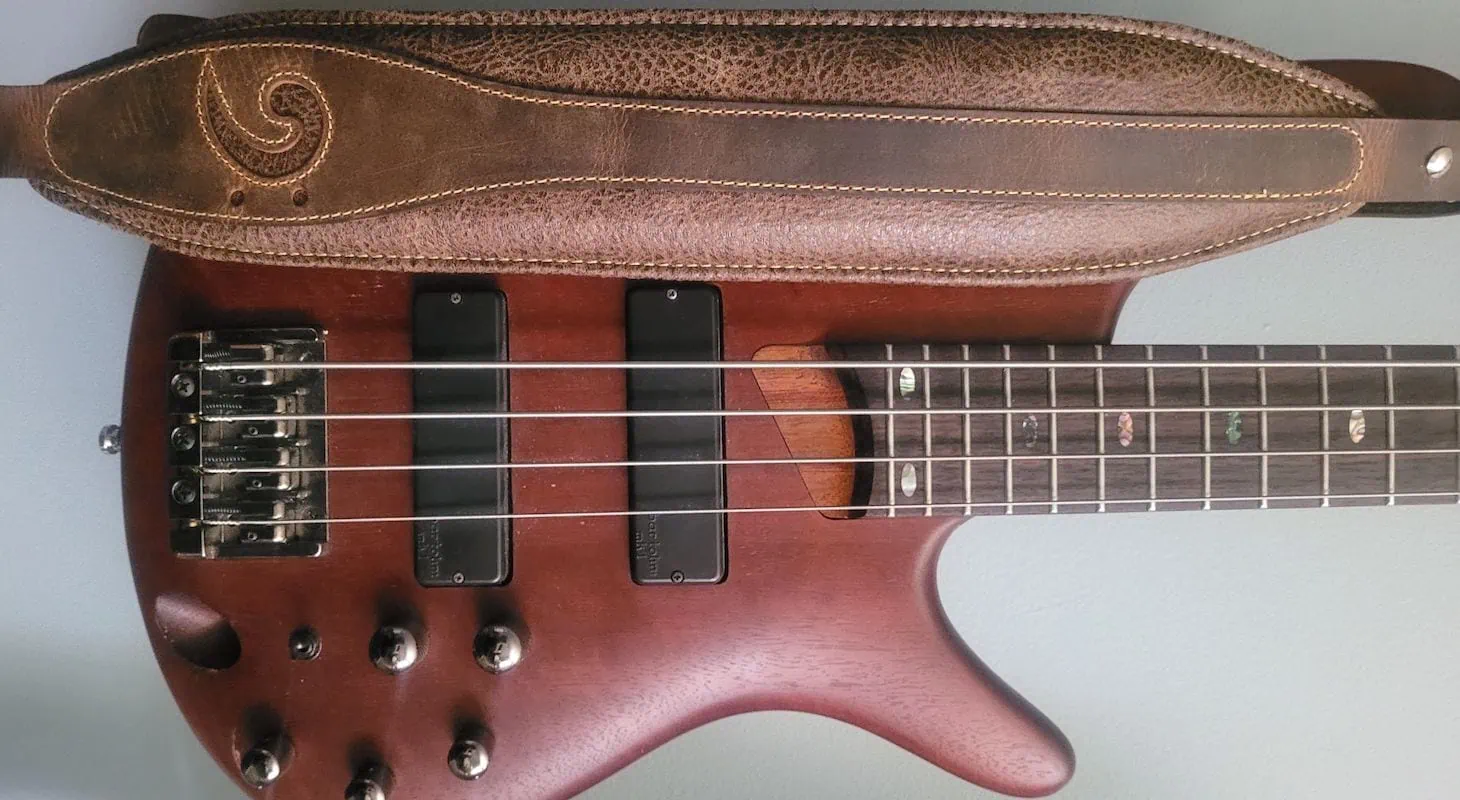The best advice I ever got as a young musician was from Bruce Kulick, who used to play in KISS. He told me to always practice standing up, never sitting down. His exact words were “when was the last time you watched a great band sit down on stage?”
I practice standing up to this day, and in order to do so, you need a reliable, comfortable strap. This is as true for bass players as for guitar players, and for those of us, like me, who manage to play both.
Top 3 - Bass Guitar Straps
Preview | Product | Price |
|---|---|---|
 | ||
 | ||
 |
Ideally, you want a bass strap that looks cool, is comfortable on your shoulder, and won’t fall apart after a few sweaty shows. A good quality strap allows you to play for longer, without fatigue becoming an issue.
6 Best Bass Guitar Straps - Get the Most Comfort!
1. LM Products X-Clef
Even though they have been around for nearly five decades, LM Products haven’t lost touch with their humble basement beginnings. Their straps are still made with the same love and care as they were in the ‘70s.
As a lifelong fan of hard-working vintage gear, I’m fairly biased in my appreciation of this style of gear.
The X-Clef is a prime example of the high-quality craftsmanship promised by LM Products. You can feel the craftsmanship of this strap as you run it through your hands.

LM Products X-Clef Bass Strap
The one-inch-thick foam core softens the strap considerably, relieving plenty of the weight of my Thunderbird. It’s not quite as long as I prefer for most of my straps, but I’m over six feet tall. Most people won’t have my issues with strap length.
The shoulder brace is securely attached to the strap, so it won’t slip away mid-gig when lubricated by sweat.
The leather tail is secured with metal rings. This makes it much easier to adjust the length of the strap. The rings make securing your preferred length pretty straightforward, too. No bass slippage mid-show with this strap. I find few things more annoying than feeling your bass slip while playing because the strap is loosening.
The X-Clef luckily doesn’t have that problem. Your bass stays put the entire time and if you want to adjust the strap it’s as simple as pulling on the tail.
As with all things guitar, how cool the gear looks is always a consideration. The bass clef detail on this strap is a nice touch for bass players who want to really let the audience know which frequency range they prefer.
It’s also a nice testament to the craftsmanship of LM Products, as this kind of leather detailing isn’t exactly easy to mass produce.
I tend to wear brown leather boots for country gigs, and the brown leather of this strap nicely matches my boots, too.
The 3.5-inch width was nice and comfortable on my frame, but if you’re built like Prince or Angus Young, you might have a hard time with such a wide strap.
The X-Clef has a slight chemical smell when you first take it out of its packaging. It isn’t very sharp and disappears after about a day of airing the strap out.
PROS
CONS
2. Levy’s MSS2
Levy’s, not to be confused with the Levi clothing brand, are makers of excellent instrument straps, bags, and accessories based in Nova Scotia, Canada (and that's where all their straps are hand-crafted). I think the MSS2 bass strap is one of their best products to date.

Levy’s MSS2 Bass Strap
This is a very well-crafted leather strap with a thick foam core. Unlike other straps with a similar design, the MSS2’s foam core spans almost the entire length of the strap.
Not only does this mean you don’t have to worry about the shoulder moving, but it also provides improved weight distribution. This is a big plus if you have a bass with a bit more heft than usual, like my Thunderbird.
I was a bit concerned that this design might make it a hassle to roll up. While I wouldn’t fold a leather strap to avoid creases and cracks, rolling up the MSS2 was actually fairly easy, although I’d take care long-term to avoid causing any damage to the interior.
At three inches wide, this strap won’t cut into your shoulder, and should fit most individuals’ frames.
Adjusting the length of the strap was fairly easy, and it gets to a robust 51 inches. At my height, if I wanted to play my bass punk-rock low, I’d need an extra ten or twenty inches of length. The range of this Levy’s strap should be enough for most bass players, especially jazz players who like it Geddy Lee-style.
Adjusting the length is fairly simple as well. The strap has several notches where the tail is threaded through. It isn’t quite as simple as pulling on the tail, but it does lock in nicely to prevent unwanted loosening. It works a lot like a standard buckled belt.
Unlike with a belt, I thread the loose “tail” through the notch at the tip, to ensure there’s nothing dangling loose off the strap.
Looks-wise, the Levy’s is nice and plain, with some pleasant pebbling on the leather. You might use it at a gig where you’re wearing a pair of vintage 501’s and black leather boots.
PROS
CONS
3. D’Addario Padded Woven Strap
The D’Addario Padded Woven is a straight-to-the-point, no thrills strap. Just like their strings, it is a well-made, durable strap.

D'Addario Padded Woven Guitar & Bass Strap
This is a bare-bones bass strap for a player who doesn’t need much. It includes some additional padding, but it lacks the foam core of other models. Its range of 43 to 58 inches is impressively longer than most other bass straps, so most bass players will find a length to suit them.
Looking at the strap it is clear that D’Addario just made a simple strap with no other purpose but to hold your bass around your neck. This strap features no extra logos or embroidery or anything.
It is just a simple and straightforward one-color design. I don’t mind a straightforward black strap: it won’t show post-gig dirt and grime. If you prefer some personality for your bass strap, this isn't for you.
I found the edge of this strap digging into my shoulder a little towards the end of the show. This was probably exacerbated by my choice to wear a relatively thin t-shirt that night, but it’s worth noting for those of us who like heavy instruments and long gigs.
The plastic loops on this strap feel durable, but I’ve seen countless straps fail over the years because the plastic loops wore out. I’d keep an eye on these loops if you’re buying this strap for long-term use.
The length of this strap is adjustable at both ends, unlike most straps, so you can easily switch up if need be.
As far as bass straps go, this unassuming, affordable entry from D’Addario will hold your bass up and keep it up. It’s bare-bones and unpretentious, and at an affordable price.
PROS
CONS
4. Gruv Gear SoloStrap Neo
If your bass starts to feel like an anvil around your neck towards the end of a show, you might want to look at the Gruv Gear SoloStrap Neo. At four inches wide, it’s offering plenty of weight distribution, and it’s made from ultra-soft Neoprene to further cushion your instrument.

Gruv Gear SoloStrap Neo
Gruv Gear boasts that the strap is engineered to minimize bouncing, which in turn minimizes the fatigue on your muscles over the course of a long gig. I have never noticed my bass bouncing mid-gig, but if you do, then this could be the solution.
The SoloStrap is extremely comfortable. I borrowed a friend’s six-string bass for a gig, and the SoloStrap made it feel as light as a feather. If your back or shoulders are complaining about your heavy instruments, the SoloStrap might be the best solution on the market.
The way the strap’s length is adjusted is a bit of a blessing and a curse. Instead of the more traditional loop system where you just pull the strap to adjust it, Gruv Gear uses a sort of locking system.
The strap uses these small screws to hold the tail in place. This means that you have to unscrew the tail every time you want to make any length adjustments.
It isn’t hard but takes much longer than just pulling on the tail. The benefit of this system is that once the tail is screwed in, it isn’t going anywhere. The strap is going to stay at the length you set it no matter what.
If you’re using the strap for different instruments with different body sizes necessitating differing strap lengths, this might be annoying. On the other hand, I don’t plan on doing any more growing (or shrinking), so having one length locked in is fine by me.
At 38-50 inches of adjustable length, the SoloStrap isn’t offering anything crazy. I do think additional length would be wise, given that this four-inch-wide strap is clearly built for larger-framed players like me.
If you have a slighter frame, you can go for the 2.5-inch version of the SoloStrap, but you won’t enjoy the same weight-relieving benefits.
PROS
CONS
5. Ernie Ball Polylock
Best known for their guitar strings, Ernie Ball also makes a variety of guitar and bass accessories. Among those accessories are straps, like the Ernie Ball Polylock.

Ernie Ball Polylock Strap
The strap has everything you should expect from a sturdy, comfortable bass strap. It has a nice and thick foam core and is a comfortable three inches wide.
The neoprene material of the strap is fairly soft to the touch. You won’t have to worry about the strap cutting into your neck, as with other cheaper straps.
Overall, the strap isn’t much to look at. It also only comes in black. If you are looking for a strap with a bit of personality, the Polylock probably won’t be the strap for you. Ernie Ball offers a variety of other straps in different colors and patterns, so perhaps in future they’ll have a Polylock in a new color.
The main feature of this strap, giving it its name, is the built-in locking ends for the strap. Gone are the days of buying separate strap locks or jimmying the red stopper off a bottle of Grolsch.
Having these on the strap itself is great because it means that your strap won’t slip off unexpectedly during a song. This also means you don’t need separate strap locks that can be a hassle to remove. I was even able to sling my bass across my back, Springsteen-style, during a bassless section of a song mid-show.
The Polylock makes it easy to remove your strap. So, if you switch instruments during a gig, you can easily unhook the strap and put it on your second bass. All while knowing that the strap will lock into place. It’s not quite as durable as old-school metal locks, but it’s a welcome innovation.
I have seen some people online claim that the strap locks aren’t compatible with every instrument. I had no issues using it but is something to keep in mind. Guitar and bass strap buttons are reasonably uniform, but if for some reason yours are nonstandard, simply ask your retailer. You should be able to easily find out from the retailer you are buying from if the strap locks will work with your instrument.
The strap locks, as well as the loops, are plastic though. While they do feel solid, I am always wary of plastic over a few years of extensive use. I tend to trust metal parts over plastic, but this innovative strap from Ernie Ball is well worth the money.
PROS
CONS
6. KLIQ AirCell
Just when I thought all guitar straps looked alike, along came the KLIQ AirCell, with its honeycomb-like design.

KLIQ AirCell Strap
Straps often have foam inside the strap, or a thick, soft shoulder pad. Instead, the AirCell features tiny pockets of air, hence the name. It looks like the underside of an ice cube tray, but it feels like marshmallows on your shoulder.
The AirCells certainly feel different from any strap I’ve tried, but after a few minutes of playing I barely noticed they were there.
Weight is spread out quite nicely and made my Thunderbird feel much lighter. The AirCells actually spread weight more evenly than just a regular thick foam pad. It’s like the difference between foam running shoes and Air Max-style hollow soles. The weight relief is really noticeable with a large, heavy instrument.
The shoulder pad is also long enough so that it covers enough of your shoulder and back.
I did, however, notice a mildly rubbery stretch with this strap. If your bass is prone to bouncing, this strap will probably make it bounce.
The stitching and neoprene feel reassuringly well put together, at least at first. The plastic loops may not hold up over time, but I wouldn’t be complaining about plastic loops in this price range. The product comes with a lifetime warranty, too, so the manufacturer clearly has faith in its longevity.
If you prefer a colored strap, you can choose from a range of colors, including camo options, perhaps for those who play in a Ted Nugent cover band.
The AirCell is one of the most comfortable straps I’ve tried, and anyone who owns a bothersome heavy bass would do well to get one.
PROS
CONS
Choosing a Bass Strap - Key Factors
Although there are certainly more exciting pieces of equipment for bassists than their straps, their importance shouldn't be overlooked. Being comfortable on stage, recording, or rehearsing is essential.
The more comfortable your strap is, the easier it is to undertake long playing sessions. You’re supposed to enjoy playing. If you enjoy practice, you’ll practice more. The more time you can spend practicing bass, the better, right?
Strap Length
Firstly, you need to establish the ideal length that you like to have your strap set to. This will depend on your height, but also on your preferences.
Take a measurement of your wingspan, the distance from one wrist to the other. Unless you’re built like a pro boxer or Olympic swimmer, this is going to be a few inches shorter than your total height.
Use this measurement as a guide for your ideal strap length. If you like your bass to sit low, you’ll need to use the full length. I’m about six feet and two inches tall, so I used to use Ernie Ball’s 72-inch straps when I played my guitars low like Johnny Ramone.
These days, I tend to play with the guitar or bass sitting higher, over the belt, so I don’t use the full length of a 72-inch strap.
The takeaway here is that a strap that is set too low or too high will significantly affect both your comfort and your playing ability.
It comes down to your own comfort level, so choose whatever works best for your frame.
Strap Width
The second thing to consider is strap width. Most bass straps have either a 3 or 4-inch width. A 4-inch width is ideal for heavier bass guitars, as they evenly spread the weight across your shoulder and prevent you from getting tired.
There is a basic principle of physics at play here and that is: Pressure = force / area
In simpler terms, as the force (the weight of your bass in this case) remains constant, the larger the contact area (in this case, the width of the strap) would be, the less pressure you'd feel on your shoulder.
Heavy basses demand wider straps, although smaller-framed individuals may struggle with a four-inch-wide strap if it’s wider than their shoulder.
Strap Material
The final consideration when choosing the best bass strap for your requirements is the material that has been used to construct it. Most straps are made from a combination of materials to blend durability with comfort.
Inner cushioned layers are common and are usually made from foam or neoprene. The outer material needs to be more robust to ensure that the strap can handle the tension without breaking or slipping off your shoulder.
Closing Thoughts
Although a new strap isn’t as exciting as a new bass, amp, or pedal, and won’t affect your tone, it’s an essential piece of your playing puzzle. A good strap will have your playing time feeling easy and comfortable.
I tend to play better when I don’t have to worry about twinges in my neck or back. In a way, the right choice of strap will make you a better musician.



